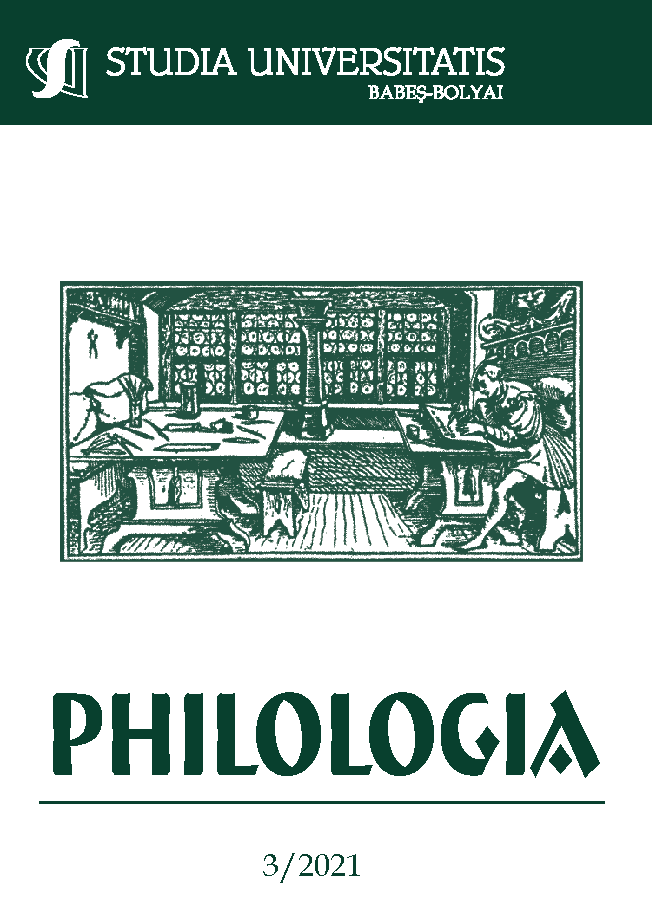NARRATIVE LANGUAGE AND POSSIBLE WORLDS IN POSTMODERN FICTION. A BORDERLINE STUDY OF IAN McEWAN’S “THE CHILD IN TIME”
DOI:
https://doi.org/10.24193/subbphilo.2021.3.16Keywords:
possible worlds, possible-world semantics, narrative worlds, fictional worlds, narrative language, fiction, postmodern fiction, fictional characters.Abstract
Narrative Language and Possible Worlds in Postmodern Fiction. A Borderline Study of Ian McEwan’s The Child in Time. The present paper is a study of more traditional hermeneutics combined with a tinge of possible world modality, with the purpose of creating a thorough picture of narrative worlds and balancing it against the possible world system, with practical applications onto postmodern fiction, in Ian McEwan’s novel The Child in Time. The article focuses on exposing narrative language, worlds and characters, viewing them through Seymour Chatman’s perspective and slightly counterbalancing this approach with the possible world semantics system (as envisioned by Kripke, Lewis, Nolan, Putnam) for a diverse understanding of the inner structure and functioning of narrative text and fictional worlds.
REZUMAT. Limbajul narativ și lumile posibile în ficțiunea postmodernă. Un studiu hibrid al romanului Copilul furat, de Ian McEwan. Prezenta lucrare este un studiu hibrid al hermeneuticii tradiționale îmbinat cu trimiteri către semantica modală a sistemului lumilor posibile, al cărui scop este acela de a se concretiza într-un studiu aprofundat al lumilor narative, prin intermediul semanticii modale a lumilor posibile, oferind aplicații practice asupra ficțiunii postmoderne, în romanul Copilul furat de Ian McEwan. Articolul se concentrează pe expunerea particularităților limbajului narativ, precum și a lumilor și personajelor ficționale, mai întâi din perspectiva lui Seymour Chatman și apoi printr-o ușoară contrabalansare a acestei abordări cu sistemul lumilor posibile (propus de Kripke, Lewis, Nolan, Putnam), oferind o imagine diversificată a structurii interne a textului narativ, a funcționalității acestuia, dar și a lumilor ficționale.
Cuvinte-cheie: lumi posibile, semantica lumilor posibile, lumi narative, lumi ficționale, limbaj narativ, ficțiune, ficțiune postmodernă, personaje ficționale.
References
Armstrong, David Malet. 1989. A Combinatorial Theory of Possibility. New York: Port Chester.
Booth, Wayne Clayson. 1983. The Rhetoric of Fiction. Chicago: The University of Chicago Press
Chatman, Seymour. 1978. Narrative Structure in Fiction and Film. Ithaca and London: Cornell University Press
Kripke, Saul. 1981. Naming and Necessity. Wiley-Blackwell
Lewis, David. 1986. On the Plurality of Worlds. Oxford: Blackwell
——. 2001. Counterfactuals. Oxford: Blackwell Publishers
McEwan, Ian. 1992. The Child in Time. London: Vintage Books
Nolan, Daniel. 2012. Topics in the Philosophy of Possible Worlds. New York and London: Routledge.
Putnam, Hilary. 1983. Realism and Reason (Philosophical Papers). Cambridge: Cambridge University Press.
——. 2011. Representation and Reality. Cambridge Massachusetts: The MIT Press.
Ryan, Marie Laure. 2004. La narración como realidad virtual. La inmersión y la interactividad en la literatura y en los medios electrónicos. Barcelona: PAIDÓS.
Downloads
Published
How to Cite
Issue
Section
License
Copyright (c) 2021 Studia Universitatis Babeș-Bolyai Philologia

This work is licensed under a Creative Commons Attribution-NonCommercial-NoDerivatives 4.0 International License.



